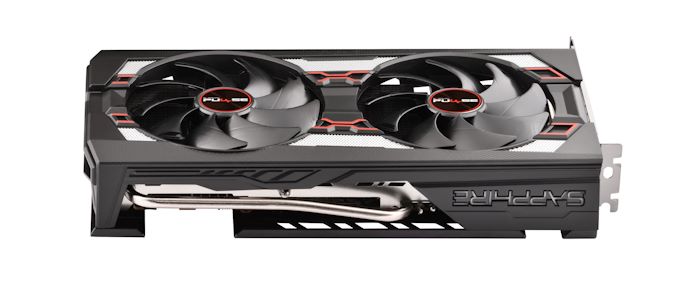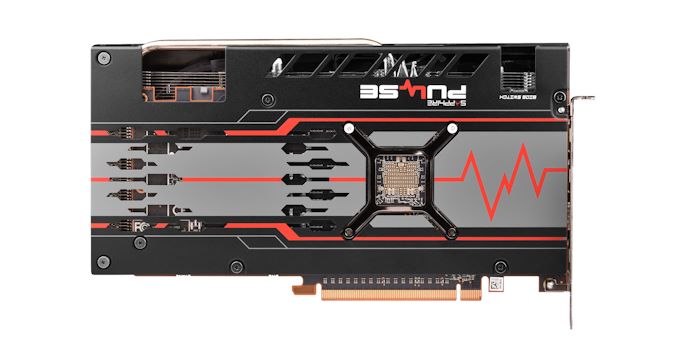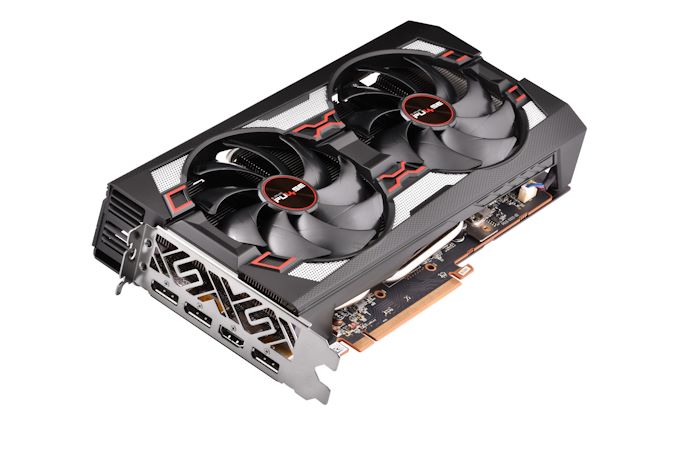The AMD Radeon RX 5600 XT Review, Feat. Sapphire Pulse: A New Challenger For Mainstream Gaming
by Ryan Smith on January 21, 2020 9:01 AM ESTMeet the Sapphire Pulse Radeon RX 5600 XT
Shifting gears, let’s talk about the actual hardware that will be hitting retail shelves today. As I mentioned towards the start of the article, AMD isn’t launching an official reference RX 5600 XT, so today’s launch is all about partner cards. To that end, AMD has sampled us with Sapphire’s Pulse RX 5600 XT. Sapphire’s card is a moderately factory overclocked card, and following AMD’s BIOS changes, is apparently a good example of what AMD wants other partner factory overclocked cards to be like.
| Radeon RX 5600 XT Card Comparison | |||||
| Radeon RX 5600 XT (Reference Specification) |
Sapphire Pulse RX 5600 XT (Quiet Mode) |
Sapphire Pulse RX 5500 XT (Default/Perf Mode) |
|||
| Base Clock | 1290MHz? | 1290MHz | 1290MHz | ||
| Game Clock | 1375MHz | 1460MHz | 1615MHz | ||
| Boost Clock | 1560MHz | 1620MHz | 1750MHz | ||
| Memory Clock | 12Gbps GDDR6 | 12Gbps GDDR6 | 14Gbps GDDR6 | ||
| VRAM | 6GB | 6GB | 6GB | ||
| TBP | 150W | ~150W | ~180W | ||
| GPU Power Limit (TGP) | N/A | 135W | 160W | ||
| Length | N/A | 10-inches | |||
| Width | N/A | 2.3-Slot | |||
| Cooler Type | N/A | Open Air, Dual Fan | |||
| Price | $279 | $289 | |||
Editor's Note: These are the specs post-BIOS update. Anyone buying the Pulse in January will want to make sure to update their card with Sapphire’s new BIOSes
Sapphire has several sub-brands of cards, including the Nitro and the Pulse. Normally the Nitro cards are their higher-priced factory overclocked cards, while the Pulse cards are more straightforward. But following AMD’s BIOS changes, that seems to have at least partially gone out the window. In any case, even with its factory overclock the Sapphire Pulse RX 5600 XT is not being positioned as a high-end card among RX 5600 XTs; at $289, it carries just a $10 premium over AMD’s MSRP.
For their Pulse RX 5600 XT cards, Sapphire has opted to factory overclock both modes for the card. The card’s default mode, which is its performance mode, ships with a ~180W TBP. This affords a rather sizable 240MHz (17%) increase in the card’s rated game clock. Meanwhile the memory clock has been increased by 2Gbps (17%) to 14Gbps. In short, in performance mode the Pulse is noticeably more powerful (and power-hungry) than a baseline RX 5600 XT.
On the flip side of the coin is the card’s quiet mode BIOS. This BIOS uses settings much closer to AMD’s own reference specs, with the 150W TBP and 12Gbps matching AMD’s. The only change here is that the card gets a milder 85MHz (6%) factory overclock, as far as the game clock is concerned.
Digging into the card, it’s clear from the start that Sapphire has overbuilt the card, particularly for cooling performance. At 10-inches long the card isn’t especially lengthy, but Sapphire makes up for that with a 2.3-slot wide cooler design and significantly taller (5.3-inch) frame. Comparing it to NVIDIA’s relatively compact dual-fan GeForce RTX 2060 Founders Edition, the Sapphire Pulse RX 5660 XT has about 50% more volume. Which, along with making the card a bit of a pain to install, affords it a lot more volume for heatsinks and fans.
The payoff for this oversized design is that Sapphire can use larger, lower RPM fans to minimize the fan noise. The Pulse 5600 XT packs 2 95mm fans, which in our testing never got past 1150 RPM. And even then, the card supports zero fan speed idle, so the fans aren’t even on until the card is running a real workload and starts warming up. The net result is that the already very quiet card is completely silent when it’s idling.
Meanwhile beneath the fans is a similarly oversized heatsink, which runs basically the entire length and most of the height of the board. A trio of heatpipes runs from the core to various points on the heatsink, helping to draw heat away from the GPU and thermal pad-attached GDDR6 memory. The fins are arranged horizontally, so the card tends to push air out via its I/O bracket as well as towards the front of a system. The card also comes with a metal backplate – no doubt needed to hold the oversized cooler together – with some venting that allows air to flow through the heatsink and out the back of the card.
Feeding the beast is an 8-pin external PCIe power cable, as well as PCIe slot power for its electricity needs. From a practical perspective this is well-provisioned for a card that will hit 180W, and with the design presumably being recycled from a 5700 series design, there’s room for a second power connector if Sapphire ever needed it.
Finally for hardware features, for display I/O we’re looking at a pretty typical quad port setup. Sapphire has equipped the card with 3x DisplayPort 1.4 outputs, as well as an HDMI 2.0b output. With daisy chaining or MST splitters, it’s possible to drive up to 6 monitors from the card.














202 Comments
View All Comments
Ryan Smith - Thursday, January 23, 2020 - link
Unfortunately Blender doesn't play nicely with new hardware. Or with AMD's currently buggy OpenCL drivers.ozzuneoj86 - Wednesday, January 22, 2020 - link
The stagnation in the sub-$300 video card market is getting pretty tiresome. I was unimpressed when the GTX 1060 6GB came out in 2016 and was barely faster than the GTX 970 from 2014 (which I bought new in early 2015 for around $250 on sale). Now, 3 1/2 years later we're getting only marginally faster products in the low $200 price range (1660, 5500xt). If you already have a card that was in the $200-$250 price range any time within the past *5 years*, you have to spend $280-$300 to get any kind of noticeable upgradeAs a comparison, that'd be like if the GTX 970 I bought on sale for $250 in 2015 (an admittedly great price, but not unheard of) had performed no better than a GTX 460... or even a GTX 470. That sounds absurd now, and yet that's what the mid range market has turned into.
philosofool - Wednesday, January 22, 2020 - link
This seems like a strange analysis to me. This card is a legit entry level 1440p card, which has never existed in the sub-$300 range before.cmdrmonkey - Wednesday, January 22, 2020 - link
nVidia is charging more and giving us less than they ever have in the past because they have no meaningful competition from AMD.Spunjji - Thursday, January 23, 2020 - link
It's true that Nvidia haven't offered anything like the value proposition that the GTX 970 was on its launch since then, and things have definitely slowed down in the GPU arena. I'm not entirely on board with this criticism overall, though.First off, it's a bit unfair to compare the price of a card you got on sale with launch pricing. The 970 launched at $330, which was an absolute steal but still more than $250.
Second, the 1060 provided performance that was better than a GTX 980 (and about 20-40% better than a 970, depending on the game and resolution) for $250. AMD countered with the 580 and, well, to be fair that was pretty much that until now.
That's why it confuses me that you'd complain now, when the 5600XT (and the price drops it inspired) means we can *finally* get performance that's 50-100% better than the 970 at a lower price. It took about twice as long as it used to, for sure, and that just seems to be how things are now.
ozzuneoj86 - Thursday, January 23, 2020 - link
Sorry, I wasn't trying to make an unfair comparison. I was just thinking more in terms of time... 5 years, which used to be an incredibly long time in this industry. If we're comparing launch dates and pricing, then it has taken six years to get a large upgrade for a GTX 970 at a lower price... though arguably the RX 5700 fit that bill last summer when it was often available on sale for $300 or a little less. To me, that makes the 5600XT with less memory a lot less interesting for only $20 less. These cards are fine if people have the money for them, but the slow progress is what is getting to me. Compared to the massive changes we've seen AMD bring about in the CPU market, the GPU market is very stale. There aren't any no-brainer purchases at any tier if you have a mid-range GPU from within the past 5 years. This is probably the closest we've come, as you said, but its by such a small margin. If we had performance like this for closer to $200 it would have shaken things up and made GPUs interesting again. Instead, we have the same back and forth about whether it's worth it to spend another $20 and get last year's 2060, or to buy a 4 year old used 1070 for $190 on eBay, or to simply lower the settings a couple notches and stick to the 6 year old GTX 970.This isn't really relevant, but... I guess my 970 actually ended up being more like $220, because I got a $30 check from nvidia due to that memory settlement. And then, well, I did sell the DLC codes that came with the card so it was closer to $200. That ends up being like $40 per year... thanks nvidia! :P
peevee - Wednesday, January 22, 2020 - link
Ryan, because you mention all the time that 6GB of VRAM might not be enough soon, can you write an article explaining the major uses of VRAM by various applications?It seems like neither compressed textures nor 3d models of everything needed at the same time (or within a few seconds) could take as much, and everything else can be preloaded quickly on the fly, especially with PCIe4x16... as it allows to update half of that 6GB VRAM every 1/10th of a second.
cmdrmonkey - Wednesday, January 22, 2020 - link
Looks okay, but nobody is going to buy it because nobody actually buys AMD video cards. If you doubt this look at the Steam hardware survey.Korguz - Thursday, January 23, 2020 - link
" look at the Steam hardware survey. " and that is 100% reliable ? BS. not every one has and uses steam, so no.. NOT a reliable metric. those that i know.. dont all run nvidia cards, some have radeons, and they dont have steam...cmdrmonkey - Thursday, January 23, 2020 - link
Steam has over 1 billion accounts and 90 million monthly users. The hardware survey has a sample size in the millions. Medical and psychological studies don't even have sample sizes like that. I'd say it's a damn good indicator of what most people are using.